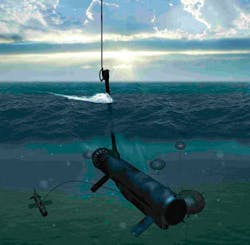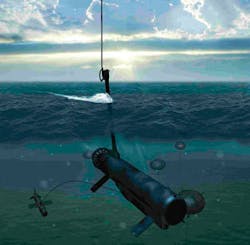By Courtney E. Howard
WASHINGTON - U.S. Navy officials revealed several firsts at the Navy League Sea-Air-Space Exposition last month in Washington, including the acceptance and deployment of two new minesweeping warships and the debut of a research-and-development center.
U.S. Navy personnel accepted delivery of the first production remote minehunting vehicle (RMV) from Lockheed Martin in Riviera Beach, Fla. The event is considered to be a milestone in the mine countermeasures capability of Arleigh Burke-class destroyers and littoral combat ships (LCS).
The RMV semi-submersible, semi-autonomous, unmanned vehicle tows a sensor capable of detecting and identifying sea mines. It sends real-time mine sonar images back to the host ship over a data link system. The RMV is part of the Navy’s AN/WLD-1 remote minehunting system (RMS), which also encompasses a launch and retrieval system for the RMV, communications equipment, and software that integrates RMS into the host ship’s combat system.
“The RMS introduces a critical mine countermeasure capability to our forward-deployed naval forces,” says Capt. Joe Spitz, deputy mine warfare program manager in the Littoral and Mine Warfare program executive office at the Washington Navy Yard. “Sailors now have an organic unmanned mine warfare system that will allow them to detect and classify mines from a safe distance. RMS allows the Navy to send a remotely operated vehicle into dangerous waters, keeping sailors out of the minefield.”
The Naval Sea Systems Command awarded Lockheed Martin a $118 million contract for seven RMVs, which are produced at Lockheed Martin’s Riviera Beach, Fla., facility.
Minehunting lasers
Beginning this month, U.S. Navy personnel will, for the first time, deploy airborne lasers to search for mines in coastal and oceanic waters.
Northrop Grumman engineers in Melbourne, Fla., delivered two airborne laser mine detection systems (ALMDS) based on a $35.7 million contract with Navy officials. The minesweeping pods are being installed on MH-60S helicopters built by Lockheed Martin Corp. in Owego, N.Y.
ALMDS pods survey waters to deeper than 40 feet for mines. ALMDS is part of the mine warfare mission package designed for four new littoral combat ships being built by General Dynamics Corp. in Falls Church, Va., and Lockheed Martin in Bethesda, Md.
Northrop engineers also are developing a system for destroying mines from the air under a three-year $36.9 million contract. The rapid airborne mine clearance system, designed to detonate mines with a 30 mm gun, will be deployed on MH-60S helicopters. Navy personnel will seek funding for 45 ALMDS pods by 2018.
R&D center to open
In other news, representatives of the Naval Undersea Warfare Center, a military research agency in Newport, revealed plans to establish a research-and-development center at the University of Rhode Island.
The first Navy-sponsored undersea technology center, the Center of Excellence in Undersea Technology is being formed to develop improved methods for marine surveillance and for supporting Navy submarines.
The center will coordinate research priorities and produce partnerships to solve technological challenges, university and military officials say. Spokesman David Sanders notes that the Naval Undersea Warfare Center issued $103 million in contracts last year to private companies in the state.
Scientists and professors from private firms and other universities-including MIT in Cambridge, Mass.; the University of Southern California; and the Woods Hole Oceanographic Institution in Woods Hole, Mass.-also will participate in research projects.




